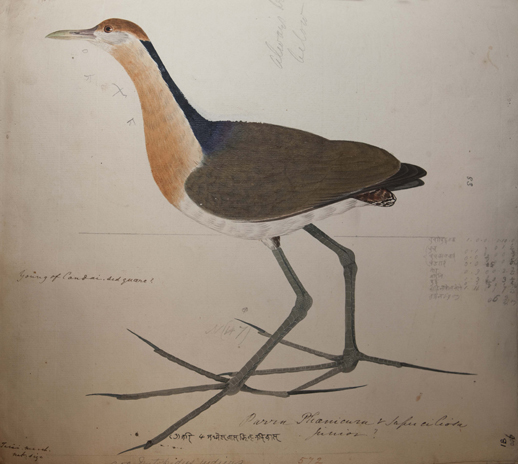 Illustration courtesy of the Zoological Society of London
Illustration courtesy of the Zoological Society of London
by Rick Beven.
I was in the hide at Koshi Camp, in the Terai plains of East Nepal, looking out over three man-made ponds covered with lotus and hyacinth. I was looking for birds that walk on water.
Thirty or forty moorhens were gabbling on the surface of the water. The right hand pond held a solitary male teal. A drab brown female floated amongst the broken lotus stalks in the central pond.
My quarry, a bronze-winged jacana, emerged cautiously from thick vegetation at the end of the central pond. Through binoculars I watched it tip toe across lotus leaves and water hyacinth, its body tilted, head down, like a clockwork toy that stopped momentarily at every revolution. Its head would flick down, turn over a piece of hyacinth and feed on the seeds and invertebrates underneath.
The same size as a moorhen, the jacana is able to walk on water because of its size twelve feet. In the afternoon light its coal black breast and neck shone the dark blue of a Hindu God. The back and wings were a startling bronze that give the bird its name. Behind its eye was an eyelash of Himalayan whiteness.
Several more jacanas appeared feeding on the fringes of the moorhens. One was startled into flight, uttering a shrill pseet pseet pseet and trailing its ridiculously long feet behind it. It lighted on lotus leaves shining silver in the slanting sunlight, bobbed to get its balance, and resumed feeding.
Jacanas have made the delicate territory between air and water their own; the moorhens were lumpenproletariat next to their water-walking daintiness. Females lay their eggs directly on to the upturned thalis of lotus leaves just before the summer monsoon, the eggs hatching into little bundles of fluff but with long feet like witches fingers.
I watched a solitary little grebe diving to feed on fish under the water and reflected how nature had carefully zoned the feeding space on the ponds: the moorhens feeding garrulously on the surface, the little grebe hunting under water and the jacanas running on lotus leaves.
More writing by Rick Beven can be found here.